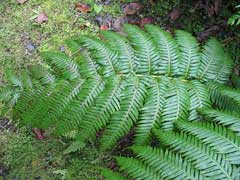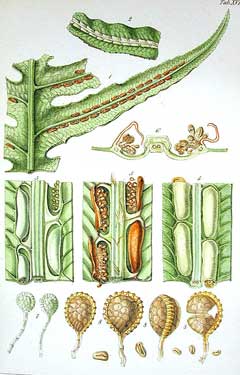 |
|
commons.wikimedia.org/wiki/User:Ixitixel |
 |
| commons.wikimedia.org/wiki/File:Woodwardia_radicans_(Bauer).jpg |
Translate this page:
Summary
Physical Characteristics

 Woodwardia radicans is an evergreen Fern growing to 1.8 m (6ft) by 0.6 m (2ft in).
Woodwardia radicans is an evergreen Fern growing to 1.8 m (6ft) by 0.6 m (2ft in).
See above for USDA hardiness. It is hardy to UK zone 9. It is in leaf all year.
Suitable for: light (sandy), medium (loamy) and heavy (clay) soils. Suitable pH: mildly acid and neutral soils. It can grow in semi-shade (light woodland). It prefers moist or wet soil.
UK Hardiness Map
US Hardiness Map
Synonyms
Blechnum radicans L.
Plant Habitats
Woodland Garden Dappled Shade; Shady Edge; Ground Cover; Bog Garden;
Edible Uses
References More on Edible Uses
Medicinal Uses
Plants For A Future can not take any responsibility for any adverse effects from the use of plants. Always seek advice from a professional before using a plant medicinally.
Anodyne Anthelmintic Astringent
Anthelmintic, astringent[178]. A decoction of the roots has been used both internally and externally in the treatment of pain from injuries[257].
References More on Medicinal Uses
Now available: PLANTS FOR YOUR FOOD FOREST: 500 Plants for Temperate Food Forests and Permaculture Gardens.
An important new book from PFAF. It focuses on the attributes of plants suitable for food forests, what each can contribute to a food forest ecosystem, including carbon sequestration, and the kinds of foods they yield. The book suggests that community and small-scale food forests can provide a real alternative to intensive industrialised agriculture, and help to combat the many inter-related environmental crises that threaten the very future of life on Earth.
Read More
Other Uses
Basketry
Plants can be grown as a ground cover when spaced about 1 metre apart each way[208]. The dried fronds and stems have been used in making baskets[257].
Special Uses
Ground cover
References More on Other Uses
Cultivation details
Requires a neutral to acid humus-rich soil[200]. Prefers growing in wet conditions, especially near running water[200]. Grows best in semi-shade[188]. This species is not hardy in the colder areas of the country, once established it tolerates temperatures down to about -5°c[200, 260] and succeeds outdoors in the milder areas[208]. Members of this genus are rarely if ever troubled by browsing deer[233]. A very ornamental plant[1].
References Carbon Farming Information and Carbon Sequestration Information
Temperature Converter
Type a value in the Celsius field to convert the value to Fahrenheit:
Fahrenheit:
The PFAF Bookshop
Plants For A Future have a number of books available in paperback and digital form. Book titles include Edible Plants, Edible Perennials, Edible Trees,Edible Shrubs, Woodland Gardening, and Temperate Food Forest Plants. Our new book is Food Forest Plants For Hotter Conditions (Tropical and Sub-Tropical).
Shop Now
Plant Propagation
Spores - best sown as soon as they are ripe, though they can also be sown in the spring. Sow them on the surface of a humus-rich sterilized soil. Keep the compost moist, preferably by putting a plastic bag over the pot. Pot on small clumps of plantlets as soon as they are large enough to handle and keep humid until they are well established. Do not plant outside until the ferns are at least 2 years old and then only in a very well sheltered position. Plants produce a plantlet at the tips of each frond. These can be detached from the parent plant and rooted in humid conditions in a frame or the fronds can be anchored down and the plantlet allowed to root in situ[200]. Division in spring[188].
Other Names
If available other names are mentioned here
Native Plant Search
Search over 900 plants ideal for food forests and permaculture gardens. Filter to search native plants to your area. The plants selected are the plants in our book 'Plants For Your Food Forest: 500 Plants for Temperate Food Forests and Permaculture Gardens, as well as plants chosen for our forthcoming related books for Tropical/Hot Wet Climates and Mediterranean/Hot Dry Climates. Native Plant Search
Found In
Countries where the plant has been found are listed here if the information is available
Weed Potential
Right plant wrong place. We are currently updating this section.
Please note that a plant may be invasive in one area but may not in your area so it’s worth checking.
Conservation Status
IUCN Red List of Threatened Plants Status :

Growth: S = slow M = medium F = fast. Soil: L = light (sandy) M = medium H = heavy (clay). pH: A = acid N = neutral B = basic (alkaline). Shade: F = full shade S = semi-shade N = no shade. Moisture: D = dry M = Moist We = wet Wa = water.

Expert comment
Author
(L.)Sm.
Botanical References
50200
Links / References
For a list of references used on this page please go here
Readers comment
| Add a comment |
|
If you have important information about this plant that may help other users please add a comment or link below. Only comments or links that are felt to be directly relevant to a plant will be included. If you think a comment/link or information contained on this page is inaccurate or misleading we would welcome your feedback at [email protected]. If you have questions about a plant please use the Forum on this website as we do not have the resources to answer questions ourselves.
* Please note: the comments by website users are not necessarily those held by PFAF and may give misleading or inaccurate information.
To leave a comment please Register or login here All comments need to be approved so will not appear immediately.
|
Subject : Woodwardia radicans
|
|
|
|